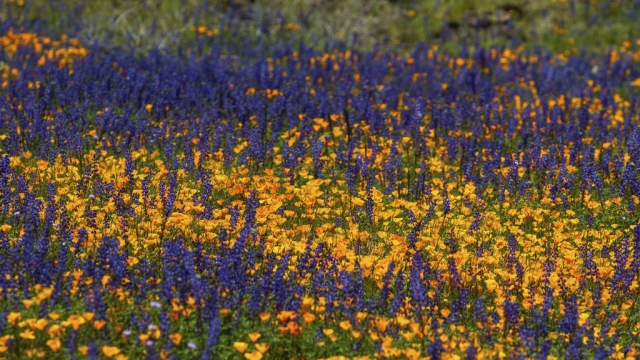In California's Central Valley, vibrant wildflower blooms are drying into brittle fuel for wildfires. Now land managers and property owners are under deadlines to clear brush and mitigate risk before peak fire season later this year.
The state's wet winter, which saw nearly two years-worth of precipitation, resulted in a so-called super bloom blanketing the low hills of the state's valleys with yellow fiddlenecks, purple lupine and orange California poppies. Tourists flocked from all over the U.S. and the world to see them, and satellite photos even captured their colorful streaks from space.
But now as temperatures rise and flowers die, what's left blanketing valley floors and hillsides are layers and layers of thick fuel for grass fires.
"Even though we have wet trees and wet soil, we still have the potential later this summer to have a lot of smaller wildfires, a lot of grass fires, and those can be dangerous," said Alex Tardy, a meteorologist with the National Weather Service.
Johna Hurl manages Carrizo Plain National Monument, a vast grassland outside Bakersfield. She told Scripps News a small grass fire Monday was a good reminder of the risks on the horizon.
"The one thing I notice is with that amount of vegetation it took a little while to get down to make sure the fire was out," Hurl said, noting fires can simmer close to the soil, invisible under layers of grass, and pop up elsewhere.
SEE MORE: Officials: Drought ends, flooding now a concern in California
State law requires brush clearing at least 100 feet away from buildings. Mitigation regulations try to limit opportunities for quickly spreading fires to jump from tall grasses to structures, like one did in Colorado in late 2021. That fire ripped across an open field with the help of high winds. It burned an entire neighborhood to the ground and killed two. In a matter of hours, it became the most destructive fire in Colorado history.
Many of the thickest deposits sitting in the wake of California's wildflowers are in rural areas, but fires that start rural can often still become a threat to human life and property.
In short, thinking California's wet winter sets the stage for an easy fire season would be a mistake.
Tardy says the state needs to be prepared for both types of fire season: The dry years, when forests are especially vulnerable to fire, and the wet years like this one, when an abundance of growth provides more fuel when it dries out later in the year. Both can be dangerous, and the state needs to be prepared for each scenario.
"With some of the climate extremes and changes that are ongoing — not just in California, but globally — the projections are, you know, be prepared for more severe conditions," Tardy said.
Trending stories at Scrippsnews.com




